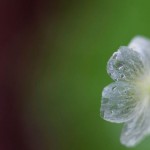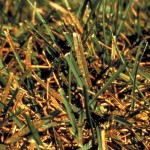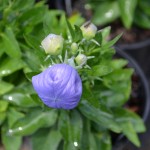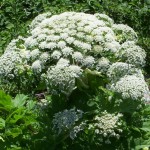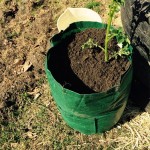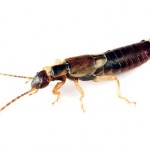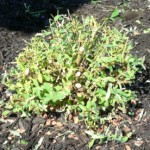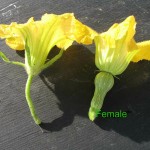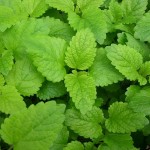“The “Skeleton Flower” (Diphelleia grayi), is a white woodland blossom that turns transparent when it gets wet. This plant can be found in three parts of the world. The plant grows on moist, wooded mountainsides in colder regions of Japan, China and the Appalachian Mountains in the United States, and it’s very easy to spot… Click here to read more…
Strawberry Growers Are Forced to Use Ozone Killing Pesticides
Farmers have been using methyl bromide since 1961, but in 1990 the Montreal Protocol mandated farmers to stop by 2005 because of its ozone destroying ways. Several government exemptions allowed farmers to continue using the fumigant, but these will all expire at the end of 2016. That sounds like a good thing — that farmers… Click here to read more…
Lawn Rust
A lot of people have been wondering about the orange powder that’s getting all over their feet and shoes when they walk across their own lawn. It’s called Rust. It’s a turf grass fungus that forms on lawns when the temperatures are warm and the air is humid. It’s much worse if you water your… Click here to read more…
What’s Hot in August? Balloon Flowers
Balloon flower, also known as Chinese bellflower, has been a favorite of many plant enthusiasts for more than 50 years, yet it’s still not found in many gardens. I hope this article and my video increase it’s popularity. Balloon-shaped flower buds pop open into beautiful blue, white, pink, or purple flowers in summer. They emerge… Click here to read more…
390-Year-Old Bonsai Tree Survived An Atomic Bomb
This 390 year old Japanese White Pine was donated to the National Arboretum in Northeast Washington for the Arboretum’s National Bonsai and Penjing Museum. Think about it! This tree has survived since the 16th century and also survived an atomic bomb! The bonsai tree’s history is being honored this week, as Thursday marks the 70th… Click here to read more…
Don’t Touch This Plant… You Could Go Blind!
Giant Hogweed is a phototoxic plant. Its sap can cause phytophotodermatitis (severe skin inflammations) when the skin is exposed to sunlight or to ultraviolet rays. Initially, the skin colors red and starts itching. Then blisters form as it burns within 48 hours. They form black or purplish scars that can last several years. Hospitalization may… Click here to read more…
Gardening Tips for August
Gardening Tips for August From the Farmer’s Almanac 5th-7th Good days for transplanting. Root crops that can be planted now will yield well. 8th-9th Any seed planted now will tend to rot. 10th-11th Plant seedbeds and flower gardens. Good days for transplanting. Most favorable days for planting beets, onions, turnips, and other root crops. 12th-16th… Click here to read more…
Can Planting More Trees Prolong Your Life?
A recent study published in the journal, Scientific Reports, compiled data from multiple cities in Toronto and came to the hypothesis that adding 10 trees to your neighborhood could result in the equivalent of feeling $10,000 richer or even 7 years younger! Trees do add beauty and shade but they also remove pollutants from the… Click here to read more…
Tips for Growing and Producing Flowers on Hydrangea
Hydrangea macrophylla, the pink and blue hydrangea are commonly known as Big Leaf or Mophead. Most of these bloom in July or August in either blue or pink, although a few varieties are white. If you have pink blooms and would like them to be blue, simply amend the soil with aluminum sulfate. Your local… Click here to read more…
Scary Mutant Flowers Growing Near Japan’s Fukushima Nuclear Disaster
On March 11, 2011, a 9.0 earthquake triggered a tsunami that hit Japan and nearly destroyed the city of Fukushima. The following day, 12 March, substantial amounts of radioactive material began to be released, and resulted in a nuclear meltdown of three of the Fukushima Daiichi Nuclear Power plant’s 6 nuclear reactors. In the four… Click here to read more…
Syracuse Professor Creates Tree Bearing 40 Types of Fruit
Grafting is the art of attaching a piece of one plant to another in such a way that the two pieces will bond together and become one plant. One plant is used to provide the root system and sometimes the stem, and is commonly known as the rootstock. If you are daring enough to try… Click here to read more…
Organic Grasshopper Control
Grasshoppers have been the bane of gardeners for centuries. These insects are responsible for consuming up to 25% of the available forage in the western half of the US each year. That’s a lot of food that could have been available to people and livestock. A heavy grasshopper infestation can reduce a garden to stubble… Click here to read more…
Are Birds Eating All of Your Fruit?
Nothing is more frustrating than watching all of the hard work you put into growing and nurturing your fruit or nut trees go to the birds! For years people have tried many methods to try and deter birds and other garden moochers from eating their crops. People have tried bird netting, sonic blasting, predator decoys… Click here to read more…
When Tillers Go Bad
The Swedish company Husqrvana is a manufacturer of outdoor power products including robotic mowers, garden tractors, chainsaws and trimmers. This past week Husqrvana had issued a recall on about 24,000 lawn and garden tillers due to the potential hazard caused by the transmission engaging itself and going either forward or backward without warning. So far… Click here to read more…
Add a Personal Touch to Your Landscape
Mike McGroarty began his career working in nurseries and starting his own landscaping business and has developed his own personal style of landscaping. You can hire a landscaper to design a beautiful yard for you but it doesn’t have to end there. You can add your own personal touch to your yard and even re-use… Click here to read more…
Growing Potatoes in Many Ways
Someone once told me about growing potatoes in used tires and I thought that sounded crazy! So I searched the internet and found out there are dozens of different ways people grow potatoes! Who knew? I decided to try it myself. Experiment 1. Potato Bags Pick the site: Plant potatoes when the danger of frost… Click here to read more…
Controlling Earwigs in Your Garden and Yard
Earwigs are unwelcome guests in most everyone’s garden or home. Earwigs can damage your plants, but they rarely bite people. These ¾” long, reddish brown insects look particularly formidable, with their rear pincers and quick movements. Their name comes from an old European superstition that these nocturnal insects will crawl into the ears, and then… Click here to read more…
Tips on Pruning Deciduous Plants
A deciduous plant is a plant that loses it’s leaves during the winter. The opposite of an evergreen. Today I have for you an article, some photos, and a video about pruning deciduous shrubs. Basically you are going to learn why it’s so important to prune on a regular basis, and exactly how much you… Click here to read more…
Why Some Summer Squash Doesn’t Mature
It happens all too often. You’ll see big blossoms on your summer squash plants and tiny little squashes forming behind the blossoms. But after a few days the blossom dries up and the tiny squash shrivels and turns brown. Why does this happen? There are a number of reasons why this may be occurring in… Click here to read more…
Attracting Beneficial Insects to Your Garden
Last week’s blog post was all about how beneficial insects can help you fight plant-eating insects in your garden. But if there aren’t any beneficial insects in your garden, they can’t come to your aid. This week you will learn how to attract beneficial insects to your garden. There are a variety of common plants… Click here to read more…
- « Previous Page
- 1
- 2
- 3
- 4
- 5
- 6
- …
- 15
- Next Page »
